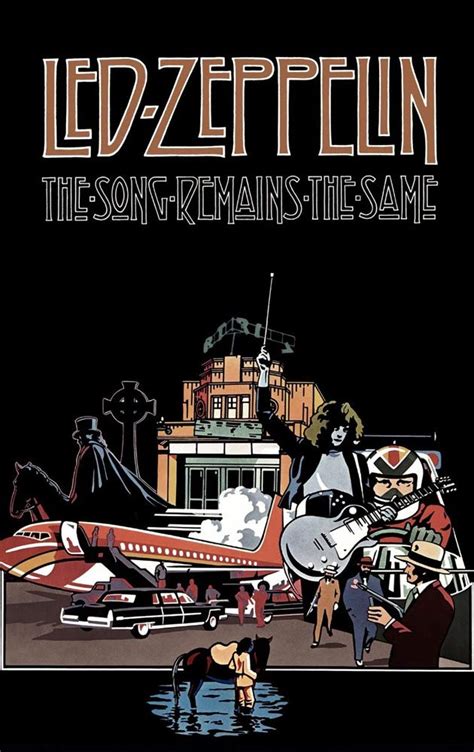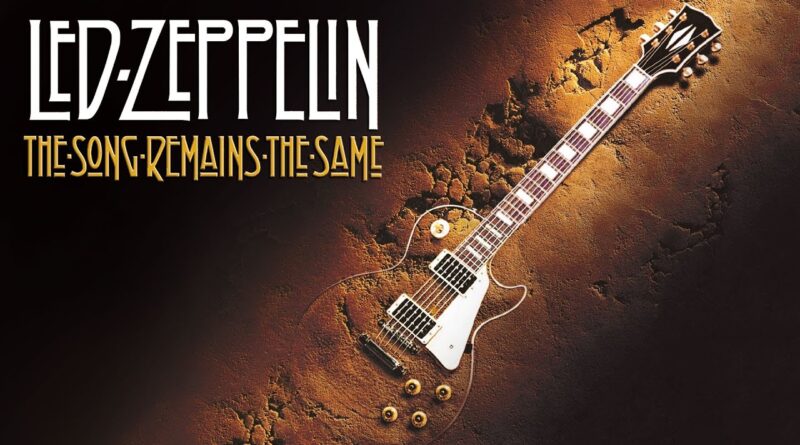The Song Remains the Same
The Song Remains the Same is a 1976 concert film featuring the English rock band Led Zeppelin. The filming took place during the summer of 1973, during three nights of concerts at Madison Square Garden in New York City, with additional footage shot at Shepperton Studios. The film premiered three years later on 20 October 1976 at Cinema I in New York, on 21 October 1976 at Fox Wilshire in Los Beverly Hills, and at Warner West End Cinema in London two weeks later.[2] It was accompanied by a soundtrack album of the same name. The DVD of the film was released on 31 December 1999.
Promotional materials stated that the film was “the band’s special way of giving their millions of friends what they had been clamouring for – a personal and private tour of Led Zeppelin. For the first time the world has a front row seat on Led Zeppelin.”
A reissue of the film, including previously unreleased footage as a bonus, was released on DVD, HD DVD, and Blu-ray Disc on 20 Nove
mber 2007, by Warner Home Video.
The plans to film the shows at Madison Square Garden were threatened when the local trades union tried to block the British film crew from working. After the band’s attorneys negotiated with the union, the crew was allowed to film the concerts.[4]
The footage of the band arriving at the airport in their private jet airliner, The Starship, and travelling in the motor cavalcade to the concert was filmed in Pittsburgh, before their show at Three Rivers Stadium on 24 July 1973.[4]
For the band’s three New York performances, two band members, Robert Plant and John Bonham, wore the same clothes to facilitate seamless editing of the film, but John Paul Jones and Jimmy Page wore different sets of attire on some of the nights, which created continuity problems. Page is seen wearing a different dragon suit in “Rock and Roll” and the “Celebration Day” remaster. In an interview from 1997, Jones said that the reason he didn’t wear the same stage clothes was that he asked the crew if they would be filming on those nights and was told no. “I’d think ‘not to worry, I’ll save the shirt I wore the previous night for the next filming’. Then what would happen is that I’d get onstage and see the cameras ready to roll.”
As Led Zeppelin’s popularity soared throughout the 1970s, Peter Grant became increasingly notorious for being brutally protective of his band and their finances; The Song Remains the Same captures one such exchange between him and a concert promoter. When Warner Bros. approved the film they did so with the proviso that expletives would be ‘bleeped‘ out. Clifton took the optical print and removed the words, and the film was given an appropriate rating. However, on every other print, the words were retained and were fully audible.[4]
In the scene where Peter Grant is driven to the police station to be questioned about the theft from the safe deposit box at the Drake Hotel, he has his arm outside the police car. According to an interview conducted in 1989, he explained the reason he wasn’t handcuffed was that the policeman driving the car used to be a drummer in a semi-professional band which had supported the Yardbirds on one of its US college tours in the late-1960s. Grant had at the time been manager of the Yardbirds.[4] The money stolen from the safe deposit box at the Drake Hotel was never recovered, and while no one has ever been charged, it is alleged that a staff member of the hotel quit their job and fled to Jamaica soon after the theft.[6] Scenes of young fans attempting to buy tickets, an unruly fan being ejected by security, and Grant berating the promoter for receiving kickbacks were all shot at the Baltimore Civic Center on 23 July 1973. Grant purportedly recommended the “Dazed and Confused” sequence wherein the camera zooms into Page’s eyes and cuts to the scene.[4] Some unused backstage shots filmed at Baltimore and at Pittsburgh later found their way into the promotional video for “Travelling Riverside Blues“, released in 1990.
Subsequent filming and release
Dissatisfied with the progress of the film, Grant had Massot removed from the project and Australian director Peter Clifton was hired in his place in early 1974. Massot was offered a few thousand pounds in compensation. Peter Grant later sent someone to Massot’s house to collect the film. However, Massot had hidden the film elsewhere and so instead an expensive editing machine owned by Massot was taken as collateral. Massot served a writ, leading to a period of stalemate which was finally broken when Grant and Led Zeppelin’s lawyer Steve Weiss agreed to pay Massot the money he was owed, after which he delivered the film to the band.[4] Massot was not invited to attend the premiere of the film at New York but he attended anyway, buying a ticket from a scalper outside the theatre.[4]
Clifton, realising that there were crucial holes in the concert footage, suggested that the entire show be recreated at Shepperton Studios in August 1974, on a mock-up of the Madison Square Garden stage. Close-ups and distance footage of the band members could then be slipped into the live sequences, which made up the bulk of the concert footage seen in the film. When it was agreed that the band would meet at Shepperton Studios for filming, Jones had recently had his hair cut short, so he had to wear a wig.[4][7]
In the May 2008 issue of Uncut Magazine, Page recalled the events surrounding the shooting of additional footage at Shepperton Studios:
I’m sort of miming at Shepperton to what I’d played at Madison Square Garden, but of course, although I’ve got a rough approximation of what I was playing from night to night, it’s not exact. So the film that came out in the ’70s is a bit warts-and-all.[8]

A plan to shoot additional footage on the band’s Autumn 1975 U.S. tour was abandoned due to Plant’s car crash in Rhodes, Greece.[6]
In 1976 a midnight screening of the film was organised by Atlantic Records before its release, at which label president Ahmet Ertegun reportedly fell asleep.[4]
The Song Remains the Same was finally completed by early 1976, 18 months behind schedule and over-budget. Peter Grant later quipped “It was the most expensive home movie ever made”.[2] It grossed $200,000 in its first week at the box office.
Critical reaction and popularity
For its New York premiere, Cinema I was equipped with a quadrophonic sound system hired from Showco in Dallas. For the West Coast premieres, no such audio boosting was employed. These premieres, along with the London premiere, were attended by the members of the band.[4]
The film performed well at the box office, grossing an estimated $10 million by 1977.[9] Despite this, the film was reviewed negatively by critics for its perceived amateurish production and self-indulgent content, with the fantasy sequences in particular coming in for some of the harshest criticism.[2][10] The film was particularly unsuccessful in the UK, where the band had not performed live for over two years as a result of being on tax exile. The band were thus unable to promote themselves at home, leaving them out of the public spotlight.[11]
However, amongst fans the film has retained its popularity. Until the release of Led Zeppelin DVD in 2003, The Song Remains the Same was the only official live visual document that was accessible to followers of the band. It became a cult favourite at late-night movie houses,[6] and its subsequent release on video and then DVD has ensured a growing base of fans.[2]
Some members of the band regard the performances filmed at Madison Square Garden as merely average for the time, coming as they did at the end of a long and exhausting tour, but nonetheless representative of the generally high standard of the band’s live performances during this era. In an interview he gave with New Musical Express in November 1976, Page stated:
The Song Remains The Same is not a great film, but there’s no point in making excuses. It’s just a reasonably honest statement of where we were at that particular time. It’s very difficult for me to watch it now, but I’d like to see it in a year’s time just to see how it stands up.
Page made good on his promise. When reviewing material for Led Zeppelin DVD in 2003, he decided to include footage from this same series of concerts.
However, other members of the band were less charitable, with Jones later admitting that the film was “a massive compromise” and Plant denouncing it as “a load of bollocks.”[9]
For all of its technical faults, many today view the film as an interesting historical document that captured the band at a particular point in time when its popularity was at around its peak, and, on a more general level, as an accurate representation of the excesses of the music and show-business industries in the 1970s.[12] In a review published in Mojo magazine following the film’s 2007 reissue, James McNair gave the film four out of five stars and wrote:
The good news is that Jimmy Page and fellow production wunderkind Kevin Shirley have been meticulous as regards quality control. The three-night, July 1973 stint at Madison square garden that fuelled the film’s original soundtrack has been plundered afresh … In truth, 2003’s DVD package houses better live performances, but if you want to catch Zeppelin in all their preposterous, ‘because we can’ glory, The Song Remains … is the one.[13]

